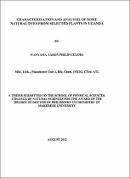| dc.contributor.author | Wanyama, Aaron P.G | |
| dc.date.accessioned | 2022-03-28T08:06:03Z | |
| dc.date.available | 2022-03-28T08:06:03Z | |
| dc.date.issued | 2012-08 | |
| dc.identifier.citation | Wanyama, Aaron P.G (2012). Characterization and analysis of some natural dyes from selected plants in Uganda.Makerere University (Unpublished work). | en_US |
| dc.identifier.uri | https://hdl.handle.net/20.500.12504/952 | |
| dc.identifier.uri | Find full text at Barclays Library Rare section | |
| dc.description | xiii, 239 p. : col. | en_US |
| dc.description.abstract | Forty different plant species with potential to yield natural dyes were collected from different
parts of Uganda between 2004 and 2008. Extraction of the plant materials was done using
distilled water after heating for 30 minutes and cooling the contents of the beaker, after
which dyeing of I00% cotton pieces of fabrics was carried out using crude extracts from
each selected plant species. The colours developed on each fabric sample varied from plant
to plant depending on the nature, structure and composition of the colour components found
in each crude plant extract, the geographical location of the plants, the mordant used, the
fabric support and the liquor ratio employed during the dyeing process.
Colour was evaluated using spectral reflectance values measured by the Datacolour SF600
spectral reflectance spectrophotometer. The colour developed on some of the dyed cotton
fabrics was evaluated for colour fastness and colour characterization using the CIELab colour
order system. The shade variation was mordant dependent and the values of the hue angle
correlated between the colour appearance of the dyed fabric samples and the phenolic
composition of the plant extracts. The surface colour yield on cotton fabrics of some of the
natural dyes investigated was determined using the Kubelka-Munk equation and was found
to vary from plant to plant. Some of the natural dyes notably Albizia coriaria, Vitellaria
paradoxa, Morindu lucida, Syzygium cordatum and Mangiferu indicawere evaluated and
exhibited good colour fastness properties, had no adverse effects on test animals occupied
mainly the yellow-red quadrant of the colour space diagram and contained in their molecular
structures characteristic colour moieties capable of dyeing textile materials as potential
alternatives to synthetic dyes. | en_US |
| dc.language.iso | en | en_US |
| dc.publisher | Makerere University (Unpublished work). | en_US |
| dc.subject | Natural dyes | en_US |
| dc.subject | Plants | en_US |
| dc.subject | Plant species | en_US |
| dc.title | Characterization and analysis of some natural dyes from selected plants in Uganda | en_US |
| dc.type | Thesis | en_US |

